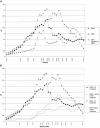Pleiotropic effects of a chromosome 3 locus on speech-sound disorder and reading
- PMID: 14740317
- PMCID: PMC1181926
- DOI: 10.1086/381562
Pleiotropic effects of a chromosome 3 locus on speech-sound disorder and reading
Abstract
Speech-sound disorder (SSD) is a complex behavioral disorder characterized by speech-sound production errors associated with deficits in articulation, phonological processes, and cognitive linguistic processes. SSD is prevalent in childhood and is comorbid with disorders of language, spelling, and reading disability, or dyslexia. Previous research suggests that developmental problems in domains associated with speech and language acquisition place a child at risk for dyslexia. Recent genetic studies have identified several candidate regions for dyslexia, including one on chromosome 3 segregating in a large Finnish pedigree. To explore common genetic influences on SSD and reading, we examined linkage for several quantitative traits to markers in the pericentrometric region of chromosome 3 in 77 families ascertained through a child with SSD. The quantitative scores measured several processes underlying speech-sound production, including phonological memory, phonological representation, articulation, receptive and expressive vocabulary, and reading decoding and comprehension skills. Model-free linkage analysis was followed by identification of sib pairs with linkage and construction of core shared haplotypes. In our multipoint analyses, measures of phonological memory demonstrated the strongest linkage (marker D3S2465, P=5.6 x 10(-5), and marker D3S3716, P=6.8 x 10(-4)). Tests for single-word decoding also demonstrated linkage (real word reading: marker D3S2465, P=.004; nonsense word reading: marker D3S1595, P=.005). The minimum shared haplotype in sib pairs with similar trait values spans 4.9 cM and is bounded by markers D3S3049 and D3S3045. Our results suggest that domains common to SSD and dyslexia are pleiotropically influenced by a putative quantitative trait locus on chromosome 3.
Figures




Similar articles
-
Linkage of speech sound disorder to reading disability loci.J Child Psychol Psychiatry. 2005 Oct;46(10):1057-66. doi: 10.1111/j.1469-7610.2005.01534.x. J Child Psychol Psychiatry. 2005. PMID: 16178929
-
Literacy outcomes of children with early childhood speech sound disorders: impact of endophenotypes.J Speech Lang Hear Res. 2011 Dec;54(6):1628-43. doi: 10.1044/1092-4388(2011/10-0124). Epub 2011 Sep 19. J Speech Lang Hear Res. 2011. PMID: 21930616 Free PMC article.
-
Further evidence of pleiotropy influencing speech and language: analysis of the DYX8 region.Hum Hered. 2007;63(1):47-58. doi: 10.1159/000098727. Epub 2007 Jan 17. Hum Hered. 2007. PMID: 17230025
-
The genetic bases of speech sound disorders: evidence from spoken and written language.J Speech Lang Hear Res. 2006 Dec;49(6):1294-312. doi: 10.1044/1092-4388(2006/093). J Speech Lang Hear Res. 2006. PMID: 17197497 Review.
-
A genome-wide search strategy for identifying quantitative trait loci involved in reading and spelling disability (developmental dyslexia).Eur Child Adolesc Psychiatry. 1999;8 Suppl 3:47-51. doi: 10.1007/pl00010694. Eur Child Adolesc Psychiatry. 1999. PMID: 10638370 Review.
Cited by
-
A common haplotype of KIAA0319 contributes to the phonological awareness skill in Chinese children.Behav Brain Funct. 2014 Jul 11;10:23. doi: 10.1186/1744-9081-10-23. Behav Brain Funct. 2014. PMID: 25015435 Free PMC article.
-
Inter-relationships among behavioral markers, genes, brain and treatment in dyslexia and dysgraphia.Future Neurol. 2010 Jul 1;5(4):597-617. doi: 10.2217/fnl.10.22. Future Neurol. 2010. PMID: 20953351 Free PMC article.
-
The genetics of reading disabilities: from phenotypes to candidate genes.Front Psychol. 2013 Jan 7;3:601. doi: 10.3389/fpsyg.2012.00601. eCollection 2012. Front Psychol. 2013. PMID: 23308072 Free PMC article.
-
The DYX2 locus and neurochemical signaling genes contribute to speech sound disorder and related neurocognitive domains.Genes Brain Behav. 2015 Apr;14(4):377-85. doi: 10.1111/gbb.12214. Epub 2015 Apr 8. Genes Brain Behav. 2015. PMID: 25778907 Free PMC article.
-
Association between AVPR1A, DRD2, and ASPM and endophenotypes of communication disorders.Psychiatr Genet. 2014 Oct;24(5):191-200. doi: 10.1097/YPG.0000000000000045. Psychiatr Genet. 2014. PMID: 24849541 Free PMC article.
References
-
- Aram DM, Hall NC (1989) Longitudinal follow-up of children with preschool communication disorders: treatment implications. School Psych Rev 18:487–501
-
- Bishop D, Adams C (1990) A prospective study of the relationship between specific language impairment, phonological disorders, and reading retardation. J Child Psychol Psychiatry 31:1027–1050 - PubMed
-
- Bishop D, North T, Donlan C (1996) Nonword repetition as a behavioural marker for inherited language impairment: evidence from a twin study. J Child Psychol Psychiatry 37:391–403 - PubMed
-
- Cardon L, Smith S, Fulker D, Kimberling W, Pennington B, DeFries J (1994) Quantitative trait locus for reading disability on chromosome 6. Science 266:276–279 - PubMed
Publication types
MeSH terms
Grants and funding
LinkOut - more resources
Full Text Sources

